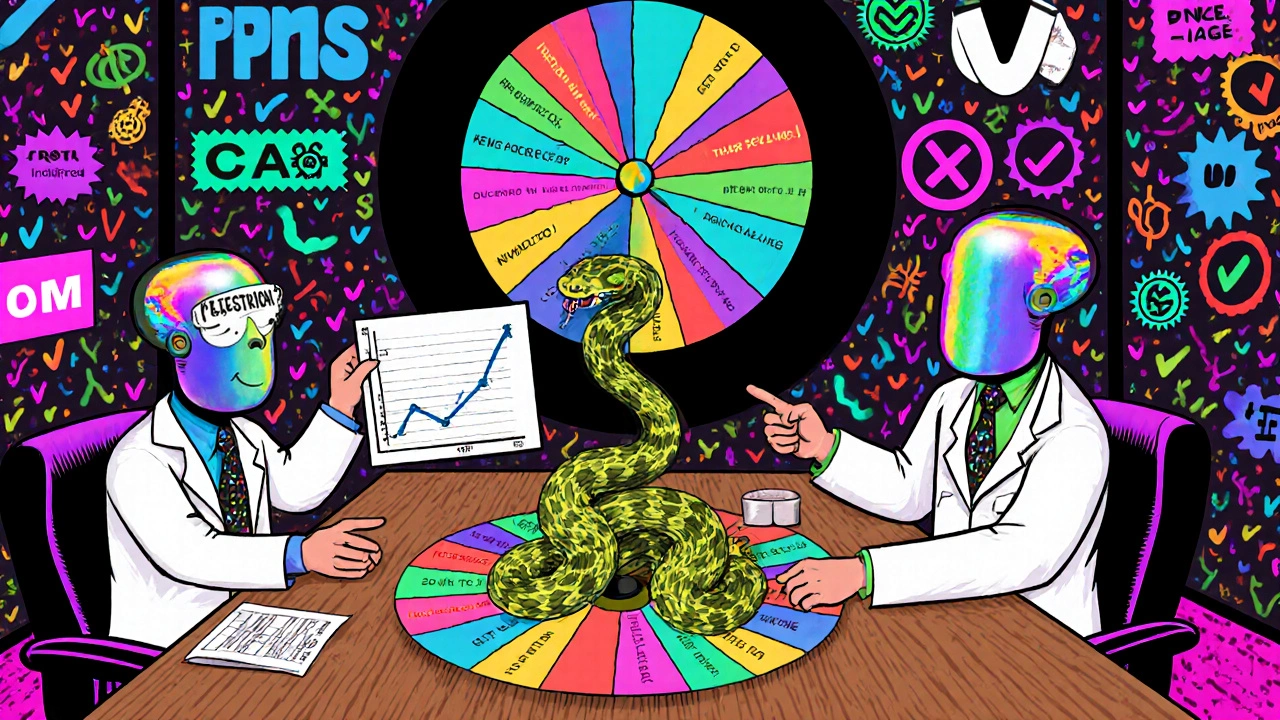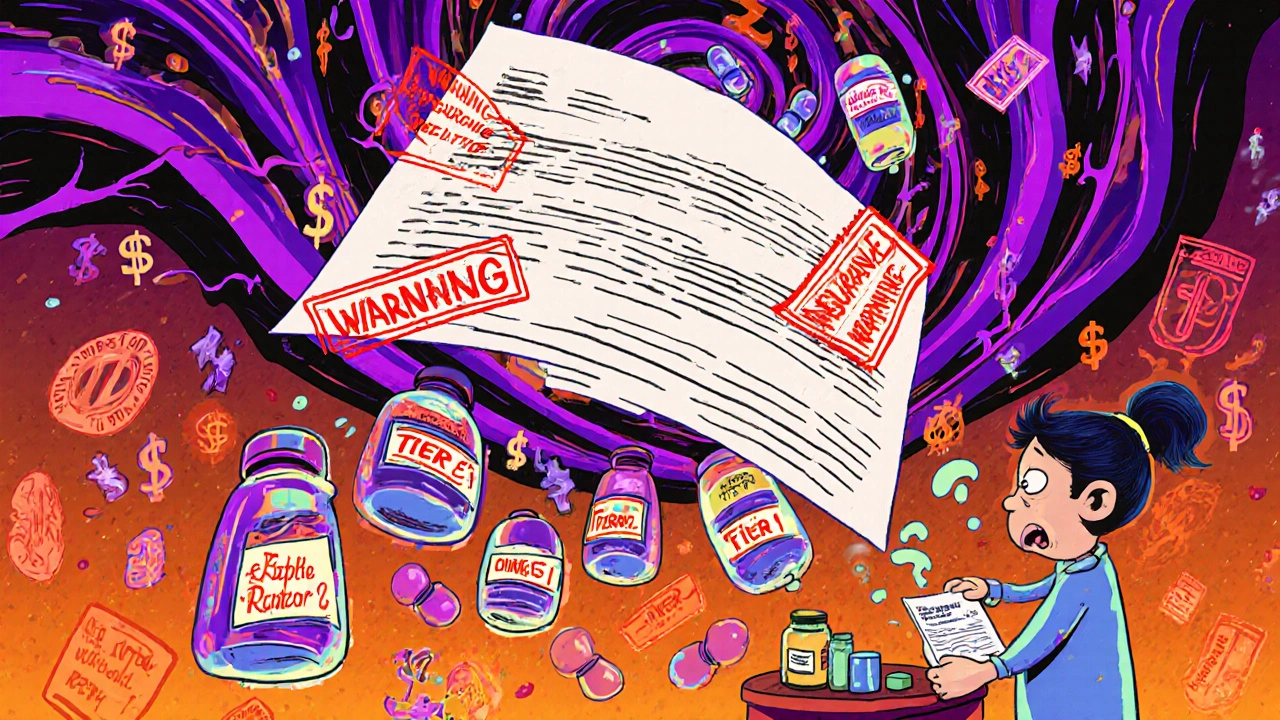Formulary Tier Cost Estimator
Calculate Your Formulary Impact
See how a tier change could affect your monthly costs. Enter your current tier and cost, then estimate potential changes.
Example: $45 for a Tier 2 medication
What Is a Formulary, and Why Should You Care?
A formulary is your insurance company’s official list of covered prescription drugs. It’s not just a catalog-it’s a decision-making tool that determines what you pay out of pocket, whether your medication is available at all, and if you need special approval to get it. Nearly every health plan in the U.S. uses one, including Medicare Part D, employer plans, and Medicaid. In 2025, with drug prices still rising and new regulations kicking in, understanding your formulary isn’t optional-it’s critical to staying healthy and avoiding surprise costs.
Formularies are divided into tiers. Tier 1 usually includes generics-drugs like metformin or lisinopril-with copays as low as $0 to $10. Tier 2 is for preferred brand-name medications, often costing $25 to $50. Tier 3 is for non-preferred brands, which can jump to $50-$100. Then comes Tier 4 or 5: specialty drugs like those for cancer, MS, or rheumatoid arthritis. These can cost hundreds or even thousands per month, sometimes requiring you to pay a percentage of the total price instead of a flat fee.
Here’s the catch: these tiers change every year. On January 1, 2025, nearly every insurance plan will update its formulary. A drug you’ve been taking for years could suddenly move from Tier 2 to Tier 4. Your $45 monthly copay could become $450. That’s not a typo-it happens more often than people realize.
How Formularies Are Made (And Who Decides)
Behind every formulary is a Pharmacy and Therapeutics (P&T) committee-usually made up of doctors, pharmacists, and sometimes even insurance executives. They review drugs based on three things: clinical effectiveness, safety, and cost. They’re not trying to be mean. They’re trying to control rising drug prices while keeping patients safe.
But here’s the reality: these committees don’t always know what it’s like to live with your condition. A drug might be just as effective as another, but if it’s cheaper, it gets priority-even if it causes side effects you can’t tolerate. That’s why 43% of patients surveyed by the National Patient Advocate Foundation reported delays in treatment because of formulary restrictions. Some ended up with worse health outcomes.
Medicare Part D plans have rules they must follow. They’re required to cover all drugs in six protected classes: antidepressants, antipsychotics, immunosuppressants, HIV/AIDS medications, anticonvulsants, and antineoplastics (cancer drugs). Commercial plans don’t have to. That means if you’re on a commercial plan and your cancer drug gets removed from the formulary, you might not have any legal recourse unless your doctor files an exception.
When Formulary Changes Hit-What to Do
Formulary updates usually happen on January 1, but changes can pop up anytime. Insurance companies must notify you if your drug is being removed, moved to a higher tier, or requires prior authorization. But here’s the problem: most people don’t read those letters. Or they get them in the mail after they’ve already filled their prescription.
Don’t wait for the letter. Check your formulary yourself during Medicare’s Open Enrollment Period (October 15 to December 7). Even if you’re not switching plans, this is the only time you can make changes without penalty. If you’re on a commercial plan, check your insurer’s website every fall-most update their formularies around the same time.
Here’s how to check:
- Find your exact plan name on your insurance card.
- Go to your insurer’s website and search for “formulary,” “drug list,” or “prescription coverage.”
- Search for each medication you take. Look at the tier, any prior authorization rules, and step therapy requirements.
- Write down the name of your drug, its current tier, and what it would cost if changed.
If you’re on Medicare, use the Medicare Plan Finder tool. It’s clunky, but it’s the only official source. User ratings for formulary transparency? Just 3.2 out of 5 stars. That tells you everything you need to know.

What to Do If Your Drug Gets Removed
If your medication is no longer covered-or it’s moved to a much higher tier-you have options.
First, talk to your doctor. Ask: “Is there another drug in the same class that’s still covered?” For example, if your brand-name blood pressure pill is dropped, there are often 3-5 other options that work just as well. Your doctor can switch you to one of those.
If there’s no good alternative, your doctor can file an exception request. This isn’t a formality-it’s a real appeal. The approval rate? Around 78% when submitted by a physician. The key to approval? Two things:
- You’ve tried and failed on a covered alternative (47% of approved exceptions)
- You’ve had a bad reaction to a covered drug (32% of approved exceptions)
Don’t just say, “I’ve been on this drug for 10 years.” That won’t cut it. Your doctor needs to document specific medical reasons. If you’ve had dizziness, kidney issues, or rashes from other drugs, write it down. Bring it to your appointment.
Some plans approve exceptions in 48 hours. Others take weeks. If you’re on a life-saving medication and the delay could hurt you, ask your doctor to request an urgent exception. That should be processed in 72 hours or less.
Special Cases: Insulin, Cancer Drugs, and Specialty Medications
Since January 2023, Medicare Part D plans can’t charge more than $35 a month for insulin. That’s because of the Inflation Reduction Act. As a result, 94% of Medicare plans removed insulin cost-sharing from their formularies. If you’re on insulin, you’re protected-but only if your plan is compliant. Double-check your formulary to make sure insulin is listed as $35 or less.
Cancer drugs are another area where formularies matter more than ever. Medicare Part D plans must cover all cancer medications, but commercial plans don’t. If you’re on a commercial plan and your oncologist prescribes a drug that’s not on the formulary, you might be stuck paying thousands. Always ask your oncology pharmacy if the drug is covered before you start treatment. If it’s not, file an exception immediately.
Specialty drugs-those for MS, rheumatoid arthritis, or rare diseases-are the most vulnerable to formulary changes. In 2023, 47% of commercial plans required prior authorization for these drugs, compared to 32% for Medicare. That means more paperwork, more delays, more stress. If you’re on one of these drugs, set calendar reminders to check your formulary every six months-not just once a year.
How to Avoid Being Caught Off Guard
Here’s a simple checklist to stay safe:
- Check your formulary every October. Don’t wait for a letter.
- Know your tier. If your drug is on Tier 3 or higher, you’re at risk.
- Keep a list of your meds. Include dosage, frequency, and why you take it.
- Ask your pharmacist. They see formulary changes every day. Ask: “Is my drug still covered?”
- Don’t refill early. If your drug is being removed, refill it only when you need it. Don’t stockpile-it won’t help if your plan denies it.
- Use the Medicare Plan Finder or your insurer’s tool. Don’t trust third-party sites like GoodRx for coverage info-they show prices, not coverage.
Also, set a reminder on your phone for November 1 each year. That’s when most insurers post their new formularies. It takes 2-5 hours to fully understand your plan’s changes. That’s not a lot of time for something that could save you hundreds-or thousands-of dollars.

What’s Changing in 2025
2025 brings big shifts. Starting January 1, Medicare Part D will cap out-of-pocket drug costs at $2,000 per year. That’s huge. It means even if your specialty drug is on Tier 5, you won’t pay more than $2,000 total. This should reduce pressure on insurers to remove expensive drugs from formularies.
But here’s the flip side: as drug prices keep rising, insurers are adding more restrictions. The Congressional Budget Office predicts formulary restrictions will increase 15-20% over the next five years. More prior authorizations. More step therapy. More denials.
Pharmacy benefit managers (PBMs)-CVS Caremark, Express Scripts, OptumRx-control 87% of commercial formularies. They’re under federal investigation for steering patients toward more expensive drugs to increase their own profits. That’s why you’re seeing more drugs get moved to higher tiers, even if they’re cheaper for the patient.
On the bright side, AI is starting to help. About 37% of PBMs now use AI to predict which drugs are most likely to cause problems. That means fewer random changes. But until that’s regulated, you still need to check your formulary yourself.
Real Stories: What Happens When You Don’t Check
One man in Florida found out his heart medication moved from Tier 2 to Tier 4 overnight. His copay jumped from $45 to $450. He didn’t notice until his prescription was denied at the pharmacy. It took him three weeks and seven phone calls to get an exception approved.
A 72-year-old cancer patient in Ohio had her drug removed without notice. She went 21 days without treatment. Her tumor grew. She ended up in the hospital.
But there are success stories too. One woman’s diabetes drug was dropped. Her doctor filed an exception. Approved in 48 hours. Same cost. No disruption.
The difference? One person checked. The other didn’t.
Final Advice: Stay in Control
Insurance companies don’t want you to understand formularies. It’s complicated. It’s confusing. They count on you not asking questions. But you don’t have to be a pharmacist to protect yourself. You just need to be proactive.
Check your formulary every fall. Talk to your doctor. Ask your pharmacist. Know your tier. File exceptions early. Don’t assume your drug is safe just because it was last year.
Medication changes aren’t just about cost-they’re about your health. And in 2025, the only thing standing between you and a coverage gap is you.

Scott Saleska
November 14, 2025 AT 02:08Look, I get it, formularies are a mess, but honestly? Most people don't care until they get hit with a $500 bill. I work at a pharmacy, and I see it every day - someone comes in, panicking because their insulin went from $35 to $350 overnight. No warning. No email. Just a denied claim. And yeah, the $2,000 cap in 2025 is great, but what about the people on commercial plans? They’re still getting screwed. PBMs are laughing all the way to the bank while we clean up the mess.
Stop waiting for the letter. Check your formulary like it’s your job - because if you don’t, it’ll become your nightmare.
Don Ablett
November 14, 2025 AT 04:59It is of considerable importance to note that the structural mechanisms underlying formulary determination are often opaque to the end-user. The P&T committee, while ostensibly operating under evidence-based guidelines, is subject to financial and administrative pressures which may not align with clinical necessity. The absence of regulatory oversight in commercial plans creates a significant disparity in patient access. Furthermore, the reliance on patient self-advocacy as a primary safeguard is, in my estimation, a systemic failure.
It is recommended that all individuals maintain a documented, updated pharmaceutical inventory and cross-reference it with insurer-provided formularies on a biannual basis, preferably during the month of October.
Kevin Wagner
November 15, 2025 AT 18:23Y’ALL. I just wanna say - this is the most important post I’ve read all year. I used to be that guy who ignored the mailers until my meds got denied. Then my wife’s MS drug got bumped to Tier 5. $1,200 a month. We nearly lost our house.
But here’s the win - we fought back. Doctor filed an exception. We documented every side effect from the cheaper junk they tried to shove us into. Got approved in 72 hours. Now I check my formulary every damn October like it’s my duty. I even made a spreadsheet. My friends think I’m nuts. I say - better nuts than broke and sick.
Don’t wait for a tragedy. Check. Ask. Fight. Your life isn’t a spreadsheet. But your meds? Yeah. They are.
gent wood
November 16, 2025 AT 11:16Thank you for this comprehensive and deeply necessary overview. The human cost of formulary mismanagement is staggering, and too often it is borne by those least equipped to navigate bureaucratic complexity. I appreciate the emphasis on proactive checking, particularly the suggestion to set a November 1 reminder - a simple, actionable step that could prevent immense suffering.
I would only add that pharmacists are underutilized allies in this process. Many are acutely aware of upcoming changes, and a brief conversation - even just, 'Is anything changing for my meds?' - can yield critical information. The system is broken, but we are not powerless.
Let us be the quiet, persistent voices that demand better, not just for ourselves, but for the elderly, the chronically ill, and the uninsured who never even get a chance to check.
Dilip Patel
November 18, 2025 AT 08:25